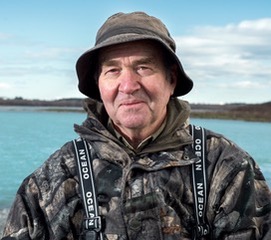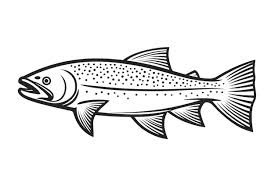Opinion by Dr Peter D. Trolove
BVSc MSc (Aquatic Veterinary Studies) MBA

A recent report from Tasmania was as follows:- “In 2024, collaboration between the Centre for Aquatic Animal Health and Vaccines and the Australian Centre for Disease Protection, facilitated advanced genomic analyses of the bacteria which resulted in the isolation of the East Coast strain of the Tasmanian Rickettsia-Like Organism (TRLO-EC) being reclassified as Piscirickettsia salmonis (P. salmonis). This work was therefore able to determine that P salmonis has in fact been present in Tasmanian east coast waters since at least 2021 and in the south east zone (the ‘channel’) since 2023 based on samples submitted at those times. This means that this bacterium is naturally occurring in the east and southeast coastal waters and it is no longer regarded as an exotic emergency disease in Tasmania”
-Kevin de Witte Chief veterinary Officer Tasmania, 17 March 2025
Comment
This story is very typical of how diseases are spread by the aquaculture industry;
Because of limited technical support in the form of experienced fish vets and state of the art laboratories, the aquaculture industry has had a long and sorry record of transmitting fish diseases globally. Diseases such as bonamia (oysters), crayfish plague (freshwater crayfish), six different viral septicaemias of penaeid shrimp (prawns), furunculosis (Aeromonas salmonicida), Infectious salmon anaemia, Viral Hemorrhagic Septicaemia, etc. etc..
Antibiotics
Set up the farm, experience the disease(s), then spend the next decade attempting to diagnose and manage the problem with antibiotics and novel vaccines.
Plumes of pathogens are released from the sea cages along with parasites such as sea lice and the gill parasite Dactylogyrus to infect susceptible wild stocks of fish including trout and salmon.
Of course the wild stocks are left to die or survive on their own devices.
This is made worse by the industry being owned by a very small number of very large global players such as Unilevers, (the massive mainly Norwegian based Mowi group), Cooke Aquaculture (USA), etc.
These companies operate globally transferring fish and fomites (equipment) to all the parts of the world where they have a presence.
Like Putty
Politicians are putty in their hands mesmerised by the eye watering amounts of capital required to be in the game and the growth potential of the industry.
In the New Zealand case, Prime Minister Helen Clark facilitated the sale of the pick of NZ’s salmon farming hatcheries and marine farms to two Malaysian brothers who made their fortune chopping down the rainforests of North Malayasia and Sarawak. This duo also own many thousands of hectares of New Zealand exotic pine plantations under the Earnslaw blocks along with a majority ownership of New Zealand King Salmon.
Political Donations
Like other mega investors in NZ these guys cannot miss – donate a couple of hundred thousand dollars to the political party in power and receive $millions of taxpayer dollars as grants in return as is the case with the unproven deep water marine farm recently consented off the East Coast of the South Island.
Yet another case of privatising profits and putting the risk on the public.
The corruption becomes embedded when our government agencies are captured and/or silenced by our politicians.
An example of this lack of independence was NZKS’s funding for the Cawthron Institute to develop biosecurity plans for the New Zealand aquaculture industry.
Responsible politics does not involve (shallow) rhetoric and “cost saving”.
The mass salmon mortalities that occurred at NZKS’s Marlborough Sounds sites were similarly retrospectively found to have lesions caused by RLOs. While the New Zealand authorities had never previously identified this pathogen, in fact its presence was first identified by laboratories in Chile after NZKS sent samples to laboratories in that country, our experts just like those in Tasmania assumed the pathogenic organisms were already present in New Zealand. This “assumption” may have been made to avoid New Zealand having to declare an exotic disease incursion. This would have meant informing client countries risking a loss of market access for our farmed salmon.
Footnote: When Colin Taylor and I visited Wellington to learn of MPI’s position on trout farming, (a prominent political topic at the time), an MPI policy advisor told us that “MAF does not have a position on trout farming as we do not understand it”!


Fsh farms take more fish than they make.
Farmed fish are usually fed fishmeal, which is ground up anchovies and other wild fish. Problem is, the farmed fish eat more than they produce in fish protein; it takes 3 pounds of fishmeal to make 1 pound of Atlantic salmon. This makes the whole idea of farmed fish as seriously flawed. By farming fish, it’s said we will avoid trashing the natural fishery.
Wrong.
And on the way, fish farms are a haven for disease in the packed pens that are far removed from the densities in the wild. Excellent points made by Dr Peter Trolove.
I recall from the trout farming battle in the 1970s, the words of the late Ben Schley, US fish hatcheries head, that fish farming is “capital intensive, high risk and marginally economic.”
It’s not the money/export spinner Minister Shane Jones imagines.
Disease is common-place and in fact has wracked fish farming efforts world wide.
MFish are woefully lacking in knowledge and of diseases as Peter Trolove points out.
Read “The New Fish” published by Patagonia about the troubles of the salmon farming industry. Fisheries Minister Jones should read it.
While MFish and the Minister are scratching their heads, they should ponder how to bring fish to the NZ consumer at a decent price. Blue Cod at $70 a kg? Snapper at $60 a kg.
MFish cannot even manage the natural wild fishery, with the commercial corporate bias of the Quota Management system.
What gets me is the lack of pre-research by Shane Jones (Minister) and MFish although as Dr Trolove points out, I doubt if the ministry has the expertise, knowledge and ability to manage fish farming. Of course it’s all very well to use somebody else’s money, i.e. taxpayers.
The Ministry and Mr Jones plans to expand salmon farming with a cash injection of millions from the Sustainable Food and Fibre Futures Fund. The fund administered by the Ministry of Primary Industries, will invest $11.7 million in salmon farming over five years as part of a $29.2 million programme led by majority foreign owned (Malaysian) King Salmon.
Utter stupidity! Ill-judged and irresponsible use of public money.
Fish farming is certainly not a new concept and is in operation globally, if managed correctly, I can’t really see a problem with it.
The problem New Zealand has, is Jones, he is blind to the consequences that his bulldozer tactics well bring letting these farms start up without the overseas professionals to identify poor practices and standards, and certainly not at the taxpayers expense
Without these, the threat and spread of deasse would be imminent.
Feeding tonnes of wild caught fish to fatten a relative handful of captive fish that require treatment for disease and parasites while all the time poisoning the benthic environment with their waste, seems like the very thing NZ needs to be staying the heck away from; clean green, 100% pure? Hmm.
Fish farms threaten marine ecosystems and endanger wild fish stocks worldwide. Fish biologists warn that other than climate change, the genetic pollution from farmed salmon is the biggest threat to Atlantic salmon’s fight against extinction. Farmed fish also require baitfish to be ground into fishmeal for food, and this method of protein production is expensive and unsustainable without government subsidies. One fifth of the entire world’s catch of wild fish goes to make this fishmeal. Small wonder it attracts investment from shady political contributors. Once again, it’s the old story of crony capitalism privatising profit while “externalizing”–or making the public pay– environmental costs. Shane Jones knows better, but either he simply doesn’t care or it even gives him a woody to make money while raping the environment. It’s a twofer! https://www.theguardian.com/environment/2021/feb/11/global-salmon-farming-harming-marine-life-and-costing-billions-in-damage